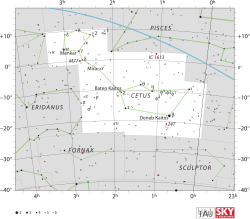2 Ceti
| 2 Ceti | |
 | |
| Observationsdata Epok: J2000.0 | |
|---|---|
| Stjärnbild | Valfisken |
| Rektascension | 00t 03m 44,38784s[1] |
| Deklination | -17° 20′ 09,5719″[1] |
| Skenbar magnitud () | +4,483[2] |
| Stjärntyp | |
| Spektraltyp | B9 IVn[3] |
| U–B | -0,12 ± [4] |
| B–V | -0,047 ± 0,003[5] |
| Astrometri | |
| Radialhastighet () | +8,0 ± 4,6[6] km/s |
| Egenrörelse (µ) | RA: +25,17[1] mas/år Dek.: -9,16[1] mas/år |
| Parallax () | 11,98 ± 0,26[1] |
| Avstånd | 272 ± 6 lå (83 ± 2 pc) |
| Absolut magnitud () | -0,06[5] |
| Detaljer | |
| Massa | 2,68 ± 0,11[7] M☉ |
| Radie | 2,75[7] R☉ |
| Luminositet | 119+6-5[8] L☉ |
| Temperatur | 11 419 ± 388[9] K |
| Metallicitet | +0,00 ± 0,24[3] dex |
| Vinkelhastighet | 116[8] eller 237[10] km/s |
| Ålder | 217[9] miljarder år |
| Andra beteckningar | |
| AKARI-IRC-V1, J0003444-172009, ALS 15812, BD-18 6417, FK5 905, GSC 05838-01288, HD 225132, HIC 301, HIP 301, HR 9098, IRAS 00011-1737, 2MASS J00034439-1720092, PHL 6232, PLX 5813, PPM 208289, SAO 147059, TD1 30267, TYC 5838-1288-1, uvby98 100225132, Gaia DR2 2414783622022208128 [11] | |
2 Ceti, som är stjärnans Flamsteed-beteckning, är en ensam stjärna[12] belägen i den västra delen av stjärnbilden Valfisken. Den har en skenbar magnitud på 4,48[2] och är synlig för blotta ögat där ljusföroreningar ej förekommer. Baserat på parallaxmätning inom Hipparcosuppdraget på ca 12,0[1] mas, beräknas den befinna sig på ett avstånd på ca 272 ljusår (ca 83 parsek) från solen. Den rör sig bort från solen med en heliocentrisk radialhastighet på ca 8 km/s.[6]
Egenskaper[redigera | redigera wikitext]
2 Ceti är en blå till vit[9] underjättestjärna av spektralklass B9 IVn,[3] som har ”diffusa” absorptionslinjer i spektret på grund av snabb rotation.[13] Den har en massa som är ca 2,7[7] solmassor, en radie som är ca 2,8[7] solradier och utsänder från dess fotosfär ca 120[8] gånger mera energi än solen vid en effektiv temperatur av ca 11 400[9] K.
2 Ceti uppskattas ha en rotation av 116[8] till 237[10] km/s, och denna höga rotationshastighet ger stjärnan en ekvatorialradie som är 12 procent större än den polära radien.[13] Ett överskott av infraröd strålning med en våglängd på 18 μm har observerats runt stjärnan av Akarisatelliten, vilket tyder på att den har ett omgivande stoftskiva.[14]
Referenser[redigera | redigera wikitext]
- Den här artikeln är helt eller delvis baserad på material från engelskspråkiga Wikipedia, 2 Ceti, 7 januari 2020.
Noter[redigera | redigera wikitext]
- ^ [a b c d e f] van Leeuwen, F. (2007). "Validation of the new Hipparcos reduction". Astronomy and Astrophysics. 474 (2): 653–664. arXiv:0708.1752. Bibcode:2007A&A...474..653V. doi:10.1051/0004-6361:20078357.
- ^ [a b] Høg, E.; et al. (2000). "The Tycho-2 catalogue of the 2.5 million brightest stars". Astronomy and Astrophysics. 355: L27–L30. Bibcode:2000A&A...355L..27H.
- ^ [a b c] Wu, Yue; et al. (2010). "Coudé-feed stellar spectral library – atmospheric parameters". Astronomy & Astrophysics. 525: A71. arXiv:1009.1491. Bibcode:2011A&A...525A..71W. doi:10.1051/0004-6361/201015014.
- ^ Nicolet, B. (1964). "Catalogue of homogeneous data in the UBV photoelectric photometric system". Astronomy and Astrophysics Supplement Series. 34: 1–49. Bibcode:1978A&AS...34....1N.
- ^ [a b] Anderson, E.; Francis, Ch. (2012), "XHIP: An extended hipparcos compilation", Astronomy Letters, 38 (5): 331, arXiv:1108.4971, Bibcode:2012AstL...38..331A, doi:10.1134/S1063773712050015.
- ^ [a b] Gontcharov, G. A. (2006). "Pulkovo Compilation of Radial Velocities for 35 495 Hipparcos stars in a common system". Astronomy Letters. 32 (11): 759–771. arXiv:1606.08053. Bibcode:2006AstL...32..759G. doi:10.1134/S1063773706110065.
- ^ [a b c d] Allende Prieto, C.; Lambert, D. L. (1999). "Fundamental parameters of nearby stars from the comparison with evolutionary calculations: masses, radii and effective temperatures". Astronomy and Astrophysics. 352: 555–562. arXiv:astro-ph/9911002. Bibcode:1999A&A...352..555A.
- ^ [a b c d] orec, J.; et al. (2012). "Rotational velocities of A-type stars. IV. Evolution of rotational velocities". Astronomy and Astrophysics. 537: A120. arXiv:1201.2052. Bibcode:2012A&A...537A.120Z. doi:10.1051/0004-6361/201117691.
- ^ [a b c d] David, Trevor J.; Hillenbrand, Lynne A. (2015). "The Ages of Early-Type Stars: Strömgren Photometric Methods Calibrated, Validated, Tested, and Applied to Hosts and Prospective Hosts of Directly Imaged Exoplanets". The Astrophysical Journal. 804 (2): 146. arXiv:1501.03154. Bibcode:2015ApJ...804..146D. doi:10.1088/0004-637X/804/2/146.
- ^ [a b] Royer, F.; et al. (2007). "Rotational velocities of A-type stars". Astronomy and Astrophysics. 463 (2): 671. arXiv:astro-ph/0610785. Bibcode:2007A&A...463..671R. doi:10.1051/0004-6361:20065224.
- ^ "2 Cet". SIMBAD. Centre de données astronomiques de Strasbourg. Hämtad 23 december 2018.
- ^ Chini, R.; et al. (2012). "A spectroscopic survey on the multiplicity of high-mass stars". Monthly Notices of the Royal Astronomical Society. 424 (3): 1925–1929. arXiv:1205.5238. Bibcode:2012MNRAS.424.1925C. doi:10.1111/j.1365-2966.2012.21317.x.
- ^ [a b] van Belle, Gerard T. (March 2012). "Interferometric observations of rapidly rotating stars". The Astronomy and Astrophysics Review. 20 (1): 51. arXiv:1204.2572. Bibcode:2012A&ARv..20...51V. doi:10.1007/s00159-012-0051-2.
- ^ Ishihara, Daisuke; et al. (May 2017). "Faint warm debris disks around nearby bright stars explored by AKARI and IRSF". Astronomy & Astrophysics. 601: 18. arXiv:1608.04480. Bibcode:2017A&A...601A..72I. doi:10.1051/0004-6361/201526215. A72.





